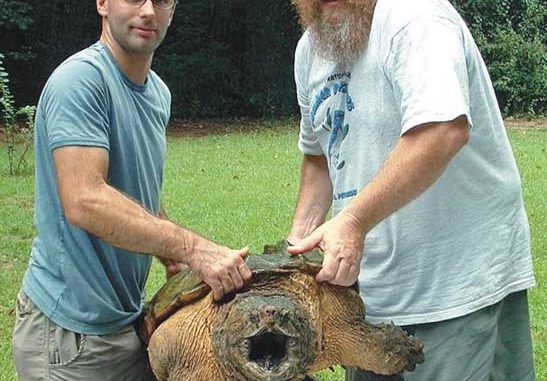
Though many half-truths have been told about alligator snappers, one thing’s no lie: These tasty specimens have a storied history in our neck of the woods.
Macrolemys temminickii, a.k.a. the alligator snapper, has been the focus of more rural tall tales than any other critter.
For decades, parents have used this ferocious-looking throwback to the Jurassic Period to keep kids out of the swamps and home after dark with stories proclaiming the beast’s preference for tasty young fingers, toes, arms and legs.
This quote from Peter Pritchard’s The Alligator Snapping Turtle is one from many such tales. Over 50 years ago, a woman told her youngsters, “It were a turtle, son. A mean ol’ alligator snapper that had et up two little boys. I suspect it’s still there, buried in the mud, jus a waiten’ on some pore chile that won’t mind its parents an’ goes in the swamp.”
There may be as much truth as fiction in that story as many fingers indeed have been lost to the alligator snapper, not so much by unsuspecting children, but by trappers whose hands got a little too close to the turtle’s powerful jaws.
Another common warning to children “fooling around” with snapping turtles is that once they lock on with their jaws, they won’t let go until the sun goes down or it thunders, etc., even after its head’s been cut off.
One documented case of turtle attack happened to Jim Christiansen, a noted herpetologist, who was carrying a 25-pounder in a burlap bag to measure and mark it.
“I was thinking of something else,” he said. “And I was holding him carelessly with his head facing my leg. He struck, sheared through the bag and my blue jeans and cut a 2-inch, fairly deep gash in my leg with his beak.”
The most unusual if not repulsive turtle legend goes like this: There was an old boy that lived up on the river who kept a big ol’ snapper he’d trained. When the police believed there was a drowning but couldn’t locate the body, they’d get the old boy and his turtle. He’d drilled a hole in the shell and rigged him up with a strong leader and line. He’d take him to where they suspected the body to be and would reel the turtle out like a kite. If there was a corpse down there, that turtle would find it.
Reliable account or just a country yarn? It’s not that far-fetched when you consider that Labrador retrievers are often perched on the bows of flatboats to catch wisps of body odor rising up from the water to locate drowning victims today.
For all the sensational and dangerous tales that snappers have created, they’re really pretty docile creatures, especially when submerged in the water. If you get the opportunity to visit the Bass Pro Shop in Denham Springs, you’ll see this clearly demonstrated by the resident turtle in the store’s pond. I’ve made visits there a week apart only to find the resident in exactly the same spot. Visitors frequently ask, “Is it real?”
No one, however, can argue that alligator snappers won’t snap — at anything or anybody that annoys them.
While its cousin, the common snapper, is much more widespread, the alligator snapper is restricted mainly to several central and southern states. The accepted record for the species is a whopping 300 pounds. Turtles with 2-foot-long shells weighing 150 pounds are much more common.
Its familiar name, “alligator” snapper, comes from its long, alligator-like tail and the three alligator-like ridges on its shell. Other local names include loggerhead and river loggerhead. You can find these turtles all over the state with the center of concentration being the Lake Maurepas/Blind River areas. They are in every parish along the Mississippi River and in fewer numbers along the Red River.
Their favorite habitat is around lakes, oxbows, large rivers and in swamps adjacent to rivers. Sometimes they’ll venture into marshes and freshwater bayous. The best time to spot them is late April through early June, the peak nesting period when females leave the water to build nests.
Despite what storytellers say, when it comes to eating, children’s fingers and toes aren’t the snapper’s favorite snack. Although they do enjoy meat, they’ll settle for just about anything. Stomach analyses show that 50 percent of their diet is vegetable and 50 percent decaying meat known as carrion. Equipped with powerful beaks, jaws and claw-tipped feet, they can easily pull apart decaying carcasses.
When it comes to living prey, snappers concentrate on insects, crustaceans like crawfish, frogs and small fish. Stories about turtles feeding on birds and mammals, while true, are probably exaggerated. Less than 2 percent of their diet is made up of birds and animals taken alive.
I personally have seen turtles catch and eat ducks in the pond on my property. Once I rescued a full grown Muscovy that I noticed was struggling to swim on its side near the bank. When I pulled it up, I found a turtle hanging on by the leg.
Alligator snappers are really more suited for different tactics than a direct attack. Because they are slow-moving except for that lightning-quick and vicious snap, they use ambush techniques, lying motionless like big rocks in wait for unsuspecting prey to approach a little too closely.
One of the most unique feeding methods of any member of the animal kingdom is the snapper’s built-in fishing lure. If you dare to get close enough to examine it, deep in its huge mouth you’ll find a small appendage that is pink (anglers make note of the color) and meaty-looking, resembling a worm that the turtle can actually wiggle. When an unsuspecting fish swims in for a meal, it suddenly becomes one.
Young turtles lying on the bottom with their mouths wide open use this “fishing” method more than the older ones. The senior citizens of the snapping turtle world, according to stomach autopsies, eat a greater variety including acorns, berries, carrion, mussels, ducks, baby raccoons and even other turtles.
Once a snapper reaches a respectable size where birds, fish and mammals are no longer a predatory threat, the only creature a mature turtle has to fear is man. Especially the “homo sapiens cajunis” found throughout South Louisiana, where turtle soups, stews and gumbos have long been delicacies.
Some turtle gourmets claim there are five different kinds of meat found on various parts of the turtle. True, there are five different colors and textures of meat coming from different parts of the carcass (similar to many other animals). But I don’t buy into the theory that each has the distinctive flavors of chicken, lamb, pork, beef and fish. It all tastes like turtle to me.
Getting turtles from the water to the table generally involves two methods. The first I’ve done with fair success and the second, well, I’ll probably never know just how successful that one can be.
The first method is to bait hooks with fish or chicken tied to a float, like a jug or Styrofoam. This doesn’t require a whole lot of skill, but a sturdy pole with a stout hook is mandatory. The hook is necessary to dislodge the line from submerged stumps which the turtle will invariably head for once it realizes it’s snagged.
The proper way to handle an alligator snapper is to grab it with one hand directly behind the head grasping the shell. The other hand holds the shell just above the tail.
Just be certain it’s an alligator snapper you’re grabbing. You see, unlike the common snapper, the alligator’s neck cannot reach around to bite the hand that holds it. If you make a one-handed grab of the shell behind the head of a common snapper, it will get very interesting very quickly.
The second method I can only describe second hand. This involves wading along the banks of rivers and ponds probing holes for resting turtles. The less-insane use a pole with a hook to pull the turtle out, while the incredibly brave or crazy, depending on how you view it, use their hands.
There are two licenses under which Louisiana residents and non-residents can legally catch turtles — either a basic resident or non-resident fishing license or a Reptile and Amphibian Collector’s license. This applies only to recreational or non-commercial activities.
Ask anyone who’s been turtle fishing or trapping for long, and they’ll tell you the alligator snapping turtle is a species in decline. Just how serious and the exact impacts caused by loss of habitat and/or over harvesting are unknown.
Trappers and processors aren’t interested in turtles weighing less than 10 pounds. The problem here is that this is approximately the same age and size where these animals reach their reproductive peak. Whenever a species is targeted to remove the spawners, there can often be population problems. This may be the case with the alligator snapper.
Loss of habitat may have contributed more to the decline than overharvesting. Water pollution, dredging and altered use of land near snapper habitat are bad news for turtle propagation.
On the bright side, since many valuable wildlife and waterfowl habitats are being preserved, the alligator snapper also benefits. Despite more restrictive limits, habitat preservation and encouragement of private farming operations, many herpetologists suspect wild populations could eventually become threatened or endangered.
Recent concern for their survival has prompted the Louisiana Department of Wildlife & Fisheries to implement both ongoing studies and more restrictive bag limits. The current recreational bag limit is one per day per person per boat or vehicle.
“We now have 12 years of population studies involving trapping, marking and releasing,” LDWF biologist Jeff Boundy said. “We have tagged the rear of the shells and released 550 turtles statewide. So far, the failure to recapture a significant number of these turtles tells us we need more studies to determine the status of alligator snapping turtles in order to make future management decisions.”
To relieve pressure on wild stocks, the commercial sale of alligator snapper meat, shells and other parts has been all but eliminated since November of 2004.
“Only about a half-dozen licensed turtle farms are allowed to sell alligator snappers that were hatched from their breeding stocks or any that may have been adults prior to the enactment,” Boundy said.
Scientists tell us that turtles first showed up on the planet about 200 million years ago and haven’t changed much at all. Personally I think any critter that has watched T-Rex come and go, witnessed the arrival of birds and the evolution of mammals to the point of training themselves to use computers will be around for a long, long time.
Maybe turtles have it all figured out. If humanity is so smart, then there’s no way we’ll allow the decimation of such a persistent survivor. At any rate, I’m pulling for the turtles.





